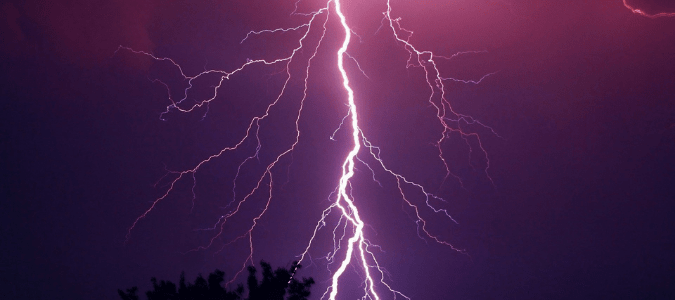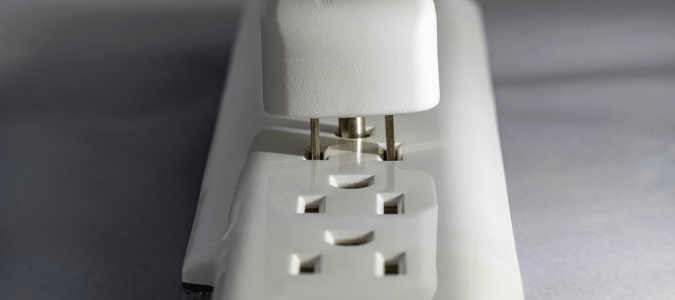A power surge in a house is a spike of high voltage. These surges last for only a short amount of time. But, they can ruin your electrical appliances and parts of your electrical system. Electronics can handle a specific amount of voltage and can only manage slight changes in voltage. For example, appliances in the U.S. are usually rated to run off of 120 volts of power. Power surges can deliver many more volts than most household equipment can stand.
Power surges in your home can happen due to internal factors, such as from the appliances in your home. They can also happen from external factors, such as when there’s a lightning storm. Let’s dive in a little deeper.
Power Surges From Inside Your Home
Situations inside a home cause around 60% to 80% of power surges in a house. One of the most common causes is any device that switches on and off inside the home. For instance, a power surge can occur when you manually change the thermostat for your air conditioner or heater. Or, you can find yourself in this situation when these systems switch on or off.
Other equipment can cause surges as well. Refrigerators, hair dryers, microwaves, fluorescent lights, power tools or computers can be linked to these surges. The transfer of static electricity between a person and an object can even cause a surge. Believe it or not, these kinds of surges are powerful enough to damage electronic equipment.
Overloaded or short circuits can also be a culprit in power surges. This could come from issues like inadequate or worn wiring. Beyond causing power failures, short circuits and wiring problems can cause fires and other problems. This is why it’s wise to have a professional inspect your electrical system if you’re having problems or even if you suspect there might be an issue.
Power Surges From Your Utility Company
Power surges can occur when a utility company disconnects and then reconnects power to the electrical grid. Utility companies sometimes need to switch between electrical grids to supply power. Or, in some cases, your provider may briefly disrupt power to the grid altogether. This can happen when a company uses different power-generation facilities to produce electricity.
This can also happen in abnormal situations that disrupt operations. For example, a fault in the line from rodent damage or high winds. When tree limbs fall on a power line or a car crashes into a utility pole, knocking it down, you can also have a disruption in your power supply.
Power Surges From a Storm
Lightning storms are one of the most well-known sources of power surges and can result in extensive damage. Lightning can cause a power surge if it strikes your electrical equipment. It can also strike nearby and send a power surge to your home through telephone, cable or power systems.
As many of us already know, the old saying “lightning never strikes the same place twice” isn’t necessarily true. And, lightning can still severely impact your home, even if it strikes far away. While the indirect effects of lightning strikes can be less problematic than the impacts of direct strikes, indirect strikes can still be destructive. When this happens, you can wind up with significant damage to the systems and equipment in your home.
Whether it’s a situation inside your house or outside, anything that causes a power surge can create problems. For one, these surges can quickly degrade anything that is on your circuit board. Damage can occur to the board itself, sprinkler controllers, fire alarms, intrusion alarms, GFCIs or garage door openers.
Additionally, power surges can degrade, damage or destroy electronics in your home. Electronics that are the most sensitive to power surges include smartphones, computers, television sets and satellite receivers. Smart home systems like remote thermostats and lock controls are also vulnerable to problems because of power surges.
Power surges can result in costly damage and can even lead to hazardous situations in your home. That’s why it’s typically best to contact a licensed electrician if you think you may have a problem. An electrician can inspect your electrical system, identify what might be causing power surges and help protect your belongings, house and family from future electrical problems. Electricians can help with smaller problems too, like any lighting issues you might have that can crop up from time to time.
With the damage that power surges can cause, you may be wondering if there’s anything you can do to prevent this problem.
How to Prevent Power Surges
Fortunately, there are steps you can take to prevent power surges and help protect your equipment. One of the easiest ways to protect equipment is to unplug it whenever you’re not using it. We understand this is difficult to remember all the time. But at the very least, it can help to unplug sensitive equipment during an electrical storm or an extreme weather event.
The most common way to protect electronics is through the use of surge protectors. Surge protectors work by diverting excess surges of electricity to the ground. When exposed to a surge, the device protects equipment by shutting off completely or by cutting off power to the equipment that’s plugged into the surge protector. The two types of surge protectors you can buy are surge strips and whole-home surge suppressors.
Surge Strips or Plug-in Surge Protective Devices (SPD)
These are surge protectors that you plug into the wall outlet in your living room, office, bedroom or den. They are a good way to protect smaller equipment, such as your laptop, printer or television. These devices can’t handle larger appliances like your oven, air conditioner or dryer.
There are two common types of point-of-use surge protectors. Some you can plug directly into the wall. Others come with a strip and several outlets that can power many appliances. Purchasing either type is an easy home improvement project that can protect your home.
Whole-Home Surge Suppressors
As the name implies, these devices will protect your entire home. And, you can use these to protect those bigger appliances such as your oven or air conditioning unit. This type of surge protector is installed at the main electrical panel.
The main panel, sometimes called a circuit breaker, is usually mounted on an outside wall of your home where power lines connect with your home. This panel measures the amount of electricity that your house draws in from the power lines. Utility companies sometimes install a surge protector as a service to their customers. If you don’t already have one, then an electrician can install a surge protector for you.
With surge protection, it’s often best to use a two-tiered approach. Even if you have a whole-home surge suppressor installed, it’s also a good idea to also use point-of-use protectors throughout your house. This is especially important for more sensitive appliances, like your computers.
Although homeowners can use plug-in surge protectors, an electrician should be contacted for other surge protection needs. To work effectively, surge protectors must be grounded properly. This can be a complicated process that is best suited for an experienced professional.
Additionally, any task involving electricity can pose a serious risk to homeowners who try to tackle it themselves. When it comes to surge protection, it’s best to contact a professional, who can handle everything for you. A professional can also upgrade your electrical panel, add electrical GFCI outlets, install switches or perform many other tasks for further peace of mind.
Many people don’t realize that surge protectors and power strips aren’t the same thing. Unfortunately, it can be confusing to tell the difference if you buy some in a hurry. So, what do you need to know about these two products? And, does it matter which you choose?
Surge Protector Versus Power Strip
Power strips often look like surge protectors. But, not every power strip will protect your electronics and appliances from harm. A regular power strip only serves to provide power to many devices at once while using the same wall outlet.
A surge protector might have the same shape as a power strip and have many outlets. But, this type of equipment will say directly on the device or on the packaging that it’s a protective device. Look for the Underwriters Laboratories (UL) logo, TVSS or SPD on the packaging. This indicates that the device is a surge protector. Underwriters Laboratories is a non-profit that tests the safety of electronics. TVSS stands for Transient Voltage Surge Suppressor. As previously mentioned, SPD stands for Surge Protective Device.
Using a surge protector versus a power strip can make a big difference. It could mean an electrical storm frying your household equipment. Or, it could mean your electronics lasting for years. If you’re unsure if you’re using surge protectors or you have questions about surge protection, contact an electrician. A licensed professional can determine what will work best for your home and give you electrical safety tips.
ABC Can Protect Your Home From Electrical Problems
You may not realize the damage power surges can cause until you experience once yourself. If you want to protect your home, contact ABC Home & Commercial Services. Our licensed electricians can perform a host of electrical services throughout your home. Whether you’re wondering if you should upgrade your electrical panel or you just have questions, we can help with your electrical needs.



